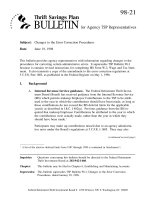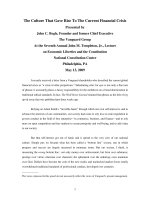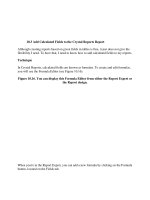designed to provide information in regard to the subject matter covered ppt
Bạn đang xem bản rút gọn của tài liệu. Xem và tải ngay bản đầy đủ của tài liệu tại đây (647.96 KB, 122 trang )
Disclaimer
This e-book is designed to provide information in regard to the subject matter
covered. Use is granted with the understanding that the publisher and author are not
engaged in rendering legal or financial advice. If expert assistance is required, the
services of a competent professional should be sought. The purpose of this e-book is to
educate. The publisher and author shall have no liability nor responsibility to any person
or entity with respect to any loss or damage caused, or alleged to be caused,
directly or indirectly, by the information contained in this e-book.
© Copyright 2003, Kay LaRocca
All rights reserved.
No part of this book may be reproduced, stored in a retrieval system, or
transmitted by any means, electronic, mechanical, photocopying, recording, or
otherwise, without written permission from the author at
Chapter One
Top “10” Job Search Techniques
Chapter Two
Creating Effective Cover Letters
Chapter Three
Resume Writing
Chapter Four
The Art of Successful Interviewing
Chapter Five
Salary Negotiation Strategies
Closing
CHAPTER ONE
TOP “10” JOB SEARCH TECHNIQUES
Authored by
Kay LaRocca, President/Owner K’s Resume Service and
BEGINNING YOUR JOB SEARCH CAMPAIGN
You've got that professional résumé in hand and you're ready to "hit the
pavement" (or the computer) and head out on your search of all searches, to find a job!
But wait, it takes much more than having just a résumé to have a successful job search
and this chapter is designed to provide you with all of the methods you will need to apply
in order to be successful. The job hunter or career changer can find job hunting to be a
very frustrating experience. In other words, it’s a job finding a job! There are no set in
stone rules for job hunting; no magic formulas or solutions. However, by utilizing all the
options available to us, we can make the job search more efficient and be successful in
the long run.
A successful job search starts with thorough preparation and planning. This is true
whether you are beginning your career, seeking re-employment or considering a more
satisfying occupation. An important step in this process is to assess your personal
characteristics; take a good look at who you are and what you have done. This will
require time and effort, but the time you invest will be worthwhile. Self-assessment can
help you to decide on a realistic job objective. The information you discover will also be
helpful when writing your resume, completing job applications and preparing for job
interviews.
Assessing Your Strengths
The self-assessment worksheets that follow are designed to help you inventory
your skills, knowledge, abilities, interests, accomplishments, values and personal traits as
they have been demonstrated in your day-to-day activities at work, school, home and in
the community. Make sure you include all your talents. Sometimes people take their
biggest positives for granted. Have someone who knows you well review your
worksheets to ensure you include all your positives. When completing this worksheet
think about "transferables." These are skills and abilities that you can take with you to a
new job. They are characteristics you have in which your new employer will be
particularly interested. Remember, the employer is going to be looking for how you can
benefit his or her organization.
Use the following form to summarize your accomplishments, abilities and
personal characteristics.
Work Experience. (Use a sheet like this for each position you have held, including military
service.)
Company:
Address:
Supervisor's Name and Title:
Dates of Employment:
Position(s)/Title(s)/Military Rank:
Duties and Responsibilities:
Accomplishments (including awards or commendations):
Skills, Knowledge and Abilities Used (Make sure you include "transferables"):
Duties Liked and Disliked:
Reason for Leaving:
Education and Training
School, College, University:
Dates of Enrollment:
Major:
Degree or Certificate:
Date:
G.P.A.:
Career-Related Courses:
Scholastic Honors, Awards and Scholarships:
College Extracurricular Activities:
Other Training: (Include courses sponsored by the military, employers or professional
associations, etc.)
Courses, Activities Liked and Disliked:
Skills, Knowledge and Abilities Learned:
Professional Licenses:
Personal Characteristics: (e.g., organizational ability, study habits, social skills, like to work alone
or on a team, like or dislike public speaking, detail work.)
Personal Activities
Professional: (association memberships, positions held, committees served on, activities,
honors, publications, patents, etc.)
Community: (civic, cultural, religious, political organization memberships, offices or positions
held, activities, etc.)
Other: (hobbies, recreational activities and other personal abilities and accomplishments)
Overall Assessment
Take a look at all the work sheets you have completed: Work Experience, Education and
Personal Activities. Considering all you have done, list your strengths and positive attributes in
each of the areas below.
Skills, Knowledge and Abilities:
Accomplishments:
Personal Characteristics:
Activities Performed Well:
.
Activities Liked:
Exploring Career Options
Review your Assessment Sheets. Do the strengths and positive attributes listed
suggest possible careers for you? Your choice of a career does not have to be limited to
the ones in which you have the most direct education, experience or training. Ask
yourself:
Do I want to remain in that field?
Would the strengths I have listed serve in a related field of work?
Would I consider returning to school to learn new job skills which are in demand?
As a recent college graduate, could I translate my strengths into a career?
Is self-employment a possibility?
In answering these questions, carefully consider personal circumstances, your
lifestyle, health, family circumstances and financial needs. Keep these factors in mind
when making career plans.
Considering everything you know about yourself, try to think of some career
possibilities that you could do well and would enjoy.
List these career possibilities below:
________________________________________________
________________________________________________
________________________________________________
________________________________________________
________________________________________________
You can obtain additional information about careers from a number of useful
publications. Three examples, published by the Department of Labor, are listed below:
Guide for Occupational Exploration (GOE). The GOE lists more than 12,000
occupations and organizes them into a structure developed specifically for career
guidance. It provides a wealth of information on how to relate your background to
jobs and where to obtain additional information.
Occupational Outlook Handbook(OOH). Designed for career guidance, it
presents useful information, including requirements and duties, for a wide variety
of jobs.
Organization is Key
Stayed organized in the hunt is imperative! It is extremely important to be
organized. Maintain a notebook with contact sheets for recording names and information
relative to your efforts. Keep copies of all job leads or ads that you respond to. Maintain
a calendar or weekly plan of action for your job hunt and record and review the number
of contacts made each week.
As stated earlier, it is a job looking for a job! If you are experiencing a career
transition, staying in the routine of a job hunt is difficult. Remember, you are marketing
yourself each and every day. Begin each day with the attitude that you are “open for
business.” Follow the plan you established for yourself and keep with it until you’ve
reached your goal. Don’t unwittingly extend your job search time by limiting the
techniques you use. There are several techniques to utilize in any job search campaign.
Job Search Technique #1
NETWORKING
Networking is a key process in job seeking, job keeping, and position
advancement. In the future it will be necessary to give greater attention to this process as
competition for good jobs becomes keener and advancement opportunities become fewer.
More and more, individuals must learn to develop and use networks of contacts if they
are to best achieve their goals and career potential.
Sixty to Ninety percent of jobs are found informally mainly through friends,
relatives, and direct contacts. The U.S. Department of Labor reports that 63.4 percent of
all workers use informal job finding methods.
Networking is both a technique and a process centered on specific goals. As such,
it involves purposeful development of relations with others by connecting and interacting
with other individuals through prospecting, networking, and informational interviewing.
Its purpose is to exchange information and to acquire advice and referrals that will assist
you in promoting your ultimate job search goal: getting job interviews and offers.
Through the process of networking you build, expand, and activate your contacts.
The basic tasks of a job search are fairly simple. Once you have figured out what
kind of work you want to do, you need to know which employers might have such jobs
and then make contact with the hiring authority. These tasks are also known as
researching the job market and generating leads and interviews. Networking, or
developing your personal contacts, is a great technique for finding out about market and
industrial trends and is unsurpassed as a way to generate leads and interviews.
Networking is nothing more than asking the people you already know to help you
find out about the job market and meet the people who are actually doing the hiring.
Mark S. Granovetter, a Harvard sociologist, reported to Forbes magazine that
"informal contacts" account for almost 75 percent of all successful job searches. Agencies
find about nine percent of new jobs for professional and technical people, and ads yield
another ten percent or so.
Simply defined, networking means meeting with people to exchange information.
Some people use networking to find a new job or increase their business, some use it to
help improve their professional and personal skills, and others simply want to develop a
supportive cast of new acquaintances.
Networking means developing and maintaining relationships with others. It
involves staying in touch with people to keep track of new ideas, services, or job
openings. Networking is most effective when done with persistence over a period of time.
And when it works, networking leads you from one contact to another. By all accepted
measures, networking is the single best way to uncover promising job leads.
Don't hesitate to talk to friends, acquaintances, and neighbors about your job
search. In reality, you are asking for advice, not charity. Most of the people you contact
will be willing to help you, if only you will tell them how. You probably know more
people than you think. The key to making progress is to start asking the right people for
the right kind of assistance.
The most difficult part of any job search is getting started. You will want to
maintain a calendar or engagement diary of appointments and contacts. You should keep
a written record of every person you contact in your job search and the results of each
contact. Your log will keep you from getting confused and losing track of the details of
your job search.
The object of your job search is to convince the person who has the power to hire
you that you ought to be working for him or her. The one you want to talk to is not
necessarily the president of a company; it is rather the one who heads the department that
could use your expertise.
How do you find the hiring authority? If you are lucky, someone you know
personally will tell you whom to see and introduce you. Otherwise, you will have to do
some homework. If you cannot find out who heads the department that interests you, call
the company and ask the operator.
Do not assume you can get to the hiring authority through the personnel
department. If at all possible, you will avoid filling out any personnel forms until you
have had a serious interview. The same goes for sending resumes. In general, resumes are
better left behind after an interview than sent ahead to generate a meeting.
Direct contact with the hiring authority is far and away the most effective job-
hunting method. Your strategy and schedule should reflect that fact, and most of your
energy should be devoted to direct contact. You may want to explore other methods of
contacting potential employers, but that should take up no more than a quarter of your
job-hunting time.
The contacts you make during your preliminary informational interviewing will
be the core of your network in your job hunt. You will also want to zero in on other
contacts within your career area. Your goal is to get referred to the person who has the
power to hire you.
To make new contacts in your career area, use the following resources:
•
People you know in the career or related area.
•
Professional organizations, associations, or unions.
•
Community service organizations such as the Chamber of Commerce, Lions, or
Rotary.
•
Department chairmen in your field at colleges and universities.
•
Professional or trade magazines.
•
Newspaper articles.
•
Yellow pages.
•
Directories at the library such as:
o
Poor's Register of Corporations
o
Thomas' Register of American Manufacturers
o
Dun & Bradstreet's Million Dollar Directory
o
Who's Who in America
o
Ward's Directory of 55,000 largest U.S. Corporations
To be effective at networking, there are certain steps you must follow, for
example:
1. Determine which organizations, positions, career path, or specific
persons are of interest to you. Do enough research so that you will be
able to talk intelligently to your new contact.
2. Ask the individual when it would be a good time to chat. Give a brief
summary of your background and what you are seeking. Focus on what
you have in common. Have a goal in mind and state your purpose.
3. Be flexible. If they offer another time for a meeting, make every effort
to make yourself available to their schedule.
4. Ask for information, direction and advice, NOT A JOB! Be prepared
and have a short list of questions or topics in mind.
5. At the meeting, be sure to ask for referrals.
6. Always listen attentively and take notes if necessary.
7. Respond to any questions directed to you with comments.
8. Be sure to bring your resume and ask for their critique of it.
9. By all means, be courteous and thankful and be sure to follow-up by
sending a handwritten note thanking him or her for their time.
Be sure that you don’t make the following mistakes:
1. Don't be too pushy or abrasive by insisting on meeting with someone
who just isn’t interested or able to speak with you.
2. Don't ask personal questions or questions about their salary.
3. Don’t ask for a job.
4. Don't overstep your time limits.
5. Don't come unprepared, either about the company, the career path, or
yourself.
6. Don't interrupt the speaker.
7. Don't focus entirely on your own needs. You're there to learn.
8. Don't ask the person to circulate your resume for you (unless he or she
offers).
9. Don’t forget to say "thank you."
10. Don't become a pest, continually calling the contact for advice and
referrals after your initial meeting.
Ask the “right” questions
Ask the type of questions that will assist you in your networking efforts. In
networking, you are trying to identify certain individuals who can assist you in finding
your next job. With that thought in mind, you will need to prepare questions that can
help you do just that.
Everyone has one favorite subject…himself or herself! We all like to talk about
what we do and who we are. Knowing this, as you begin to talk to people ask them about
their line of work or industry. If what they say has relevance to your job search, inquire
further about their organization. At some point, express an interest in their company and
ask them whom they would recommend you talk to regarding a possible employment
opportunity. This is known as getting a referral. In your networking efforts, you should
always try to get a referral. You may wish to ask the person you are speaking with, how
they feel about using their name when contacting the individual they suggested.
The overall objective of networking is to build relationships. When speaking with
someone, be sure to give him or her your undivided attention. Politely ask for a business
card. Write down any pertinent information on the back of the card after you have
concluded your conversation. It may be helpful to also send a letter or handwritten note
after that conversation thanking the person for his/her time.
Networking Resources
Identifying whom to network with is a challenge for most job seekers. However,
the average person knows at least 250 people. When you really begin to consider all the
people you have encountered, you will probably come up with a number very close to
250. Networking means connecting, and there are a number of ways to connect,
including in person, by telephone, email or through a card or letter. Let’s look at where
you can find your network so you can get started on your search!
The first one we will identify is our Personal Network. The personal
network would be those individuals such as family, friends, acquaintances, work peers,
vendors, customers, teachers or professors, our children’s friends, parents, our parent’s
friends, our child’s baseball, soccer, or basketball coach; in other words, people we see or
have seen on a regular basis. Check your address book, holiday card list, old business
cards, and business listings as sources for personal contacts. If you haven’t had recent
contact with these individuals, don’t let that deter you from networking with them. After
all, they will probably be very happy to be in contact with you. Make a list of 25 people
from your personal network that you can contact within the next 7 to 10 days.
Another networking resource would be your Service Providers. These are
individuals that you have developed a rapport with that may have provided a business
service, or you may have come in contact with among the local population. Consider
your community leaders, small business people and the local chamber of commerce.
Below you will find a listing of potential professional contacts from your service
providers.
Financial Planners Dentists Hairdressers
Attorneys Community Leaders Barbers
Accountants Clergy College Professors
Business Owners Realtors Bankers
Insurance Salespeople School Personnel Physicians
Senior Executives Salespeople Store Clerks
Business Consultants Executive Recruiters Veterinarians
Restaurant Owners Caterers Bartenders
Now you will want to make a list of 15 people to contact from your service
provider list.
Professional organizations you are involved with provide a great way to network
while staying updated on your industry or occupation’s latest trends. If you currently
don’t belong to any professional organizations you may want to consider joining an
appropriate one for you. Professional organizations post job opportunities from other
members on their web sites. Besides the networking opportunity, professional
associations offer professional growth and development through their many educational
programs and services. If you are unsure of the right association for you, you may wish
to consult the Encyclopedia of Associations or do an on-line keyword search.
Networking situations can occur when you least expected. Networking
opportunities can occur in any social situation. A party, standing in line, sitting next to
someone. Many times, we find ourselves in an unplanned or opportunity networking
situation. The conversation can begin as “small talk”, and move to a more personal topic
such as our line of work. This is a tremendous opportunity to network by applying what
you learned about listening and asking the right questions earlier in this e-book.
To assist you in your networking efforts, we’ve provided a Networking Contact
List on the following pages. This will help you to stay organized as you build your
contacts.
NETWORKING LIST
Contact Name: ___________________________________________________
Network Event & Date: _________________________________________
Comments:
________________________________________________________________
________________________________________________________________
________________________________________________________________
________________________________________________________________
Contact Name: ___________________________________________________
Network Event & Date: _________________________________________
Comments:
________________________________________________________________
________________________________________________________________
________________________________________________________________
________________________________________________________________
Contact Name: ___________________________________________________
Network Event & Date: __________________________________________
Comments:
________________________________________________________________
________________________________________________________________
________________________________________________________________
Contact Name: ___________________________________________________
Network Event & Date: _________________________________________
Comments:
________________________________________________________________
________________________________________________________________
________________________________________________________________
________________________________________________________________
Contact Name: ___________________________________________________
Network Event & Date: _________________________________________
Comments:
________________________________________________________________
________________________________________________________________
________________________________________________________________
________________________________________________________________
Contact Name: ___________________________________________________
Network Event & Date: __________________________________________
Comments:
________________________________________________________________
________________________________________________________________
________________________________________________________________
Job Search Technique #2
COLD CALLING BUSINESSES
You've read all about it: Internet recruitment, networking, referrals, and more! But
often, these methods take up too much time and waiting. Now, my next suggestion is
possibly the most powerful, yet difficult strategy to get your foot in the career door of your
choice - cold calling, the art of uninvited job-hunting.
Before you dismiss this as "simply beneath me", consider the odds that four-fifths of
the job market is "closed", meaning you won't find out about available openings until they
come up for advertisement. The hiring cycle is a long and arduous one. It begins with the
internal identification of a position opening by a manager or supervisor. The lead-time to
process this vacancy up until its appearance in an advertisement can often take from six to
nine months. Hiring is expensive. By cold calling, you're saving the company time, money
and resources by placing yourself on a platter for them to consider even before any
advertisement has been launched. And even if there are no immediate vacancies available,
you gain by getting a vital contact name and inside company information, such as particular
application periods or how exactly the company recruits. In the long run, should you have
made an impression, your name and Resume may be stored for future openings before they
even go "open".
Just as all responsible entities must do, let me warn you of the pitfalls of this strategy.
"Cold-calling", or calling employers directly, is often a very difficult task for most people
unless you're born with a sales talent and a "thick skin". Cold calling means making contact
with people whom you have not had any previous contact and selling yourself in such a way
that you set up an interview for yourself or convince them to keep you at the top of their
minds should a position come up in future. Some people say it's like a radio ad: Concise, to
the point, focused at meeting the employer's needs, charismatic and informative about
yourself. The key to cold calling is to be prepared for anything. At any point in the process,
you could find yourself dealing directly with the person who is responsible for hiring. You
must always be ready to sell yourself and your skills.
So Where Do I Start?
There are several parts of the cold-calling process. Each part has some similarities to
what professional telemarketers do when preparing to market their product:
1. Craft yourself a list of choice employers.
The first step in this process is compiling at list of all companies that you would be
interested to work with. The more, the merrier; the longer the list, the better your odds
at success. You can source for this list via your personal network, the yellow pages,
corporate websites, business listings from industry publications and even your local
Chamber of Commerce directory. You could create this list of companies by focusing
on a specific geographic area, a particu
lar industry, corporate rankings, or the like. Do
some research into the career opportunities in your field of profession with each
company as far as possible before progressing further. This ensures that you don't
waste your time with organizations that won't be able to match your career goals.
Once they pass this test, narrow your search to an address, contact name and
number/email of the hiring manager or supervisor in the department of your choice. If
these are not indicated on directories or websites, make a call to the general line and
ask for this contact from the receptionist so that you get direct connection with the
person responsible for hiring. (Often, this means bypassing Human Resources and
going directly to the source of the vacancy.)
2. Get your pitch down pat.
Your pitch is your personal introduction. To ensure you're not tongue-tied at the
crucial point of a telephone conversation, prepare a short script to guide you on your
self-introduction to the prospective employer. A simple outline includes an
introduction, an explanation of your purpose, summarizing three top skills you
possess pertinent to the type of job you are inquiring about, finding about immediate
or potential vacancies, asking if you might send them a copy of your Resume or
arrange an interview date. A pitch allows you to relax and focus on what you need to
say and how to say it prior to calling an employer. Be sure to relate your previous
professional experience with what this new company needs. You may have more than
one pitch that you refer to depending on the type of job that you are applying for.
3. Practice makes perfect.
Telephone etiquette is extremely important in cold calling as this is your first point of
contact with the prospective employer. So don't get sloppy!
Here are some tips to help
you get it right:
o
Practice your script either with a friend or another job seeker, making him/her
work through different scenarios as the secretary or employer;
o
Tape record yourself to ensure you come off as calm, clear and confident;
o
Identify yourself. Don't assume the person you are calling will recognize your
voice or that the secretary has passed on your name. If you were referred by
someone else, mention their name;
o
Talk to the right person (the hiring authority) at the right time. Be aware that
businesses have busy or inconvenient times when they would not appreciate a
phone call: for example, 12:00 noon just before lunch or at the end of the
month for accounting firms;
o
Keep control of the conversation. If the person you want is not in, never leave
a number and passively wait for your call to be returned. Inquire about another
time to call and promise to call again later;
o
Put on your good phone voice. Don't mumble or shout. Talk at a moderate
pace. Be friendly and precise;
o
Get down to business. People don't have time for small talk, so get to the point
briefly;
o
In your anxiety to be heard, don't forget to listen - it's a two-way thing.
Remember, you need to motivate your listener to pave the way for you, so
listen when they are speaking. Take notes if that will help you! If you can't
provide answers to questions asked spontaneously, tell them you'll get the
answers and call them back when you say you will;
o
Ask for a meeting (interview) at a definite time, yet do it as "lightly" as
possible. Give them alternative options, for example: "Would Wednesday
morning or Thursday afternoon be more suitable for you, Mr. _______?" If
the employer informs you that there are no positions available, ask for an
informational meeting to f
ind out more about the company. That will help you
get to know more people within the company and make connections for future
use.
o
Get it down on paper. Write brief notes while on the phone to record what was
discussed and agreed upon between you and the contact and when it took
place. Memory is a fleeting thing. Don't rely solely on your memory. Transfer
this to your job tracking sheet so that you are always on the right page should
a contact call back.
4. Prep your cold call toolkit.
Before you pick up the telephone, make sure you have the following in hand: your
pitch, company research notes, a copy of your relevant Resume, a calendar, pen and
paper, your "contact tracking" sheet formatted for notes on the date, time, person,
company, address, telephone, reason for calling, follow-up date, interview date/time,
and comments.
5. Practice getting past gatekeepers.
One of the hardest parts of the process is reaching the person who does the hiring.
Secretaries or operators are there to screen calls for busy individuals. So, a few
methods are beneficial in bypassing these gatekeepers. One of them is to take
advantage of automated "dial the extension of the person you want" features. If you
do not know what it is, connect at random and courteously ask if they can connect
you to the person you're after. It may take several calls before you compile enough
information to find the right person. Remember, this won't work unless you're
pleasant and nice to the other person, who may be busy too. So use this technique
carefully.
6. How to break the ice
Be genuine. Try to avoid reading a script like most telemarketing people do, and open
the conversation with intelligent points. Knowledge of company projects underway
and intended areas of expansion and development is crucial to breaking the ice with
an employer. For example: "I remember reading recently that the company was
bringing out a new product to the market. I must say, after reading the specifications
on this product (try naming the product if you know what it’s called) I am really
looking forward to its launch. I've worked in the field of marketing in this industry
and I know the potential of this product. I want to be a part of the team to work on
this product and I know that I can contribute a great deal of expertise towards the
marketing campaign. Is your company looking at expanding its Product Marketing
team for this upcoming launch?"
7. When the going gets tough
“Why should we hire you?" "How will your experience help my team?" "What proof
can you give me that you can generate revenue for this company?" Reading off a
Resume won't help you answer these tough questions. You have to anticipate them
and know how to respond in a relevant manner.
8. Don't let it get you down.
Be prepared for negative responses but don't let "No" be the end of your conversation
if you believe that you have a future with this company. Never argue. Practice
sidestepping objections by presenting alternative ways to fill a need with your skills.
By preparing for common objections, you stand a better chance of swaying negative
attitudes to place your candidacy in a better light. Should the end of the discussion be
a dead end despite your efforts, use this experience to prepare for your next cold call.
9. When to hang up.
Be true to your mission - an appointment for an interview or application details - and
don't hang up until you've either achieved the goal or exhausted all possibilities.
10. Wind down by following up.
If ever there was a time to be true to your word, this is it. Make sure you follow up
with that fax, or call, email that response, send in those documents or call back at a
better time. This is a representation of your respect for the company and contact, and
a measure of your professionalism.
Cold calling may not be the easiest route to a job, but it has proven to be effective and
advantageous to anyone on the trail to career nirvana. Whichever way the cold call turns out,
you can only win - a new job, new inside contacts, or valuable information on hiring cycles
or practices.
Through the means provided above, identify at least 25 companies you want to target.
Job Search Technique #3
GROWTH OPPORTUNITIES
Have you ever thought about how new positions are created? As a business
grows, it discovers that more people are needed to perform all of the duties that need to
be done. If you could only know when that situation would be present, you could submit
your resume and beat your competition and secure employment. It is very possible to do
just that but you must look for growth opportunities!
Everyday we encounter growth opportunities. We see those opportunities on the
television, hear about them on the radio, and read about them in the newspaper. Growth
opportunities are situations occurring in a company that would facilitate new positions.
The factors to stimulate job growth would be company growth, expansion, reorganization
or relocation. Examples of company growth would be contract awards, growth in
earnings, issuance of IPOs, moving to a larger facility. Examples of expansion would be
introduction of a new product or venturing into a new market. Reorganization would be
promotion of an executive. Many new executives are more comfortable hiring new staff
and relocation of a company would mean new jobs created.
When learning of a growth opportunity, think about how your skills, experience,
and background could benefit that organization. Tailor your cover letter demonstrating
ways you might be of “service” to that company. Sometimes companies in “distress” can
be a growth opportunity, especially if you can demonstrate an action plan for a business
turn around plan of some sort.
Consider how you can help a company? What experiences and skills do you
possess that a company in a growth mode may benefit from?
Write a paragraph describing how you could help a company. Next, review the
business section of your newspaper or a local business journal, and over a one-week span,
identify 5 companies that could use your help.
Job Search Technique # 4
CREATE A JOB
While discussing growth opportunities, we recognized the importance of
researching company expansion, reorganization and relocation as a way to anticipate job
growth and meet that need. However, along with that idea is the thought of creating your
own job and proposing the new position to a company.
With the changing job market, it is apparent that the concept of lifetime
employment is gone. If these trends continue, we will see more individuals’ careers
comprised of working for companies and doing consulting work. In fact, a “typical” 30
year work experience will probably have 3 to 5 years at a company, work as an
independent consultant 1 to 2 years, work for another company 3 to 5 years. This really
forces us to take responsibility for our career and understand the skill sets and knowledge
base we offer organizations. This mind set will assist us in creating our job.
The crux in creating a job is organizational need. In other words, what do you
provide that an organization can benefit from? As you review the newspapers or trade
journals, keep that thought in mind. Here’s an example. You read about a company
losing money in the last quarter. Why did they lose money? Was it market conditions or
more related to an internal problem, procedure, etc. You may discover after a little
investigation, that an opportunity exists for you to create a job that will assist them in
their business turnaround.
The process of creating a job begins by viewing it as a job proposal. First, state
the situation, as you perceive it. In other words, a description of the organization’s
current problems or challenges. Next, state the various scenarios that could occur if the
present course of events does not change. Most likely, these scenarios will not be too
favorable to the future of the organization.
The third element of your proposal would identify strategies that assist the
organization in altering their current course. Obviously, the strategies involved would be
derived from your experience and would have a positive affect on their bottom line. The
last section of your proposal will express your interest in meeting with the organization to
discuss these issues further. Keep in mind, you can use this idea in approaching a
company as either an employee or a consultant. Much of that depends on your individual
circumstances.
When you hear of a company that could benefit by your experience, write out a
proposal of how you could help them. Search out five companies that you feel could
benefit from your skill set and submit your proposal letter.
Job Search Technique #5
NEWSPAPER ADS
Employers, employment agencies, or recruiters might place classified job ads.
When a job ad is identified or “open”, the company’s name will be listed with the
advertisement. When the advertisement is unidentified or “blind”, the company’s name
is not given.
Use your own judgment to determine whether you meet the job requirements
listed in an advertisement. You do not have to meet every job requirement listed. The
closer the match, of course, the better your chances are for obtaining an interview.
Although many organizations place advertisements in major newspapers and
elsewhere in their attempts to recruit, you should be aware that your chances of getting
the job you want by replying to such ads are relatively slim. Nevertheless, as paradoxical
as it seems, you should always respond when you read an ad that appeals to you. The
reason is simple: Ads are a very small time investment. Ads can also be an opportunity
to “try on” a job you hadn’t though of before.
Employment advertisements may appear in the business or the classified sections
of newspapers. Take time to look through your local papers, particularly the Sunday
issues, very carefully. Ads of interest to you may appear under more than one heading.
Most trade and professional journals also have display and/or classified sections that
might be worth following.
Open Ads
An open ad lists not only the qualifications an individual employer is looking for,
but also includes the name and address of the company. In addition, the ad might identify
the person whom you should contact.









